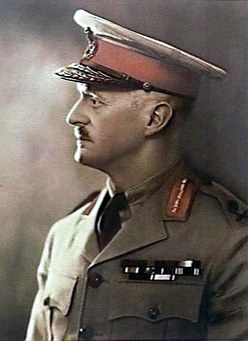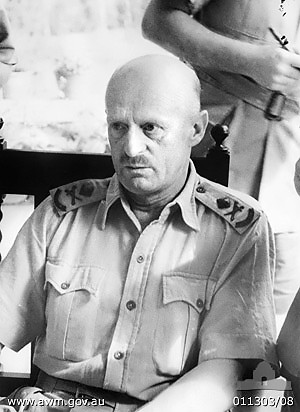Gordon Bennett (general) facts for kids
Quick facts for kids
Henry Gordon Bennett
|
|
|---|---|

Bennett in 1962
|
|
| Born | 15 April 1887 Balwyn, Melbourne |
| Died | 1 August 1962 (aged 75) Dural, Sydney |
| Allegiance | Australia |
| Service/ |
Australian Army |
| Years of service | 1908–1944 |
| Rank | Lieutenant General |
| Commands held | III Corps (1942–1944) 8th Division (1940–1942) 2nd Division (1926–1932) 9th Infantry Brigade (1921–1926) 3rd Infantry Brigade (1916–1918) 6th Battalion (1915–1916) |
| Battles/wars | World War I
World War II |
| Awards | Companion of the Order of the Bath Companion of the Order of St Michael and St George Distinguished Service Order Volunteer Decoration Mentioned in Despatches (8) Knight Commander of the Order of Prince Danilo I (Montenegro) |
| Spouse(s) |
Bess Buchanan
(m. 1916–1962) |
| Children | 1 daughter |
| Other work | Orchardist; company director; board chairman |
Lieutenant General Henry Gordon Bennett (15 April 1887 – 1 August 1962) was an important Australian Army officer. He served in both World War I and World War II. He achieved great things in World War I, becoming the youngest general in the Australian Army. However, Bennett is most remembered for his role during the fall of Singapore in February 1942. As commander of the 8th Australian Division, he escaped while his soldiers became prisoners of the Imperial Japanese Army. After this, Bennett's military career slowed down. He never commanded troops in battle again. In 1945, his escape caused a lot of debate. It led to a special investigation, which found his escape was not justified.
Before World War I, Bennett worked in insurance. After the wars, he continued his business interests. He also stayed in the military part-time. He retired from the Army after World War II and became a farmer. He remained active in business and as a military writer. He passed away in 1962 at age 75.
Contents
Gordon Bennett's Early Life
Bennett, who was always known as Gordon, was born in Balwyn, Melbourne, on 15 April 1887. His father, George Bennett, was a school teacher. Gordon was the sixth of nine children. He went to Balwyn State School and then Hawthorn College. He was very good at mathematics. In 1903, at age 16, he started training to be an actuary at the AMP Society.
In May 1908, just after turning 21, Bennett joined the Militia. This was Australia's reserve military force. He quickly rose through the ranks. By 1912, at age 25, he became a major. He spent most of his free time on his military duties.
Fighting in World War I
When World War I started in 1914, Bennett joined the Australian Imperial Force (AIF). He became second-in-command of the 6th Battalion. This battalion was part of the 2nd (Victorian) Infantry Brigade. Before leaving for overseas, Bennett got engaged to Bess Agnes Buchanan. She gave him a miniature photo of herself. He carried it in his jacket. This photo later saved his life on the Western Front by stopping a German bullet.
Gallipoli Battles
The 1st Division, including Bennett's battalion, was sent to Egypt for training. Then, they were chosen to fight in the Gallipoli Campaign. On 25 April 1915, during the landing at Anzac Cove, Bennett fought on the southern side of the Anzac beachhead. He led 300 men to a position called Pine Ridge. He was wounded in the shoulder and wrist. His younger brother, Godfrey, was killed in the fighting. Bennett refused to leave and returned to his battalion after treatment.
In early May, Bennett's battalion moved to Cape Helles. They were there to help British forces in the Second Battle of Krithia. On 8 May, Bennett advanced with his battalion in very difficult conditions. He was the only officer from his battalion to survive without serious injury. A Turkish bullet hit his ammunition pouch, exploding the ammunition. He was knocked down but not hurt. He and a few men made the furthest advance of the attack. The next day, he became commander of the 6th Battalion. He was promoted to lieutenant colonel.
In August, the 6th Battalion was involved in an attack during the Battle of Sari Bair. They tried to capture a Turkish position called German Officers' Trench. Two attempts failed. Bennett wanted to lead a third attempt himself, but the attack was called off. The 6th Battalion lost 80 men killed and 66 wounded.
After this, Bennett was hospitalised with paratyphoid. He was appointed a Companion of the Order of St Michael and St George (CMG). He was also mentioned in official reports twice for his service at Gallipoli.
On the Western Front
In March 1916, Bennett's division moved to France. He led the 6th Battalion through the Battle of Pozières. His men faced heavy artillery attacks. On 26 July, Bennett reported: "My men are being unmercifully shelled. They cannot hold out if an attack is launched." His battalion had 190 casualties, which was the lowest among the 1st Division's battalions.
In November, Bennett went on leave to London. He met his fiancée, Bess, and they married on 16 November. After a short honeymoon, Bennett returned to the front. On 3 December 1916, he was given command of the 3rd Infantry Brigade. He was promoted to brigadier general, becoming the youngest general in the Australian Army at 29. He led the brigade through many battles, including Bullecourt, Menin Road, and Passchendaele.
For his service on the Western Front, Bennett received many awards. He received the Order of Danilo from Montenegro in 1917. He was appointed a Companion of the Order of the Bath in 1918. He also received a Distinguished Service Order in 1919. He was mentioned in official reports six more times.
Between the World Wars
After the war, Bennett returned to Australia. He worked in business, including as a clothing manufacturer. He also became chairman of the New South Wales Repatriation Board in 1922. In this role, he helped soldiers who had returned from the war.
Bennett remained active in the Militia, Australia's part-time army. From 1921 to 1926, he commanded the 9th Infantry Brigade. Then he commanded the 2nd Division. In 1930, he was promoted to major general. He often disagreed with the full-time army officers. In 1937, he wrote newspaper articles about his concerns for Australia's defence.
World War II and Singapore
When World War II started in 1939, Bennett was not chosen for a top command. This was partly because of his strong opinions about British and Australian regular officers. In July 1940, he took command of a training depot. In August 1940, he became commander of the new 8th Division.
In February 1941, the 8th Division was sent to Malaya. This was to help defend against a possible Japanese attack. Relations between Bennett and his British superiors were not good.
The Malayan Campaign
In December 1941, the Japanese invasion of Malaya began. Bennett commanded a group called "Westforce." This included Australian and Indian units. The Japanese pushed the defenders back. In January, the Australians fought battles around Gemas and Muar. They had some success but were eventually forced to retreat to Singapore.
On Singapore, Bennett's command defended the north-western part of the island. On 8 February 1942, the Japanese attacked across the Johore Strait. They focused on Bennett's troops. The Australians fought hard but were forced to withdraw. Heavy fighting continued for a week. On 15 February, the Allied commander, Lieutenant General A.E. Percival, began surrender talks with the Japanese.
Bennett's Escape from Singapore
That night, Bennett decided it was his duty to escape from Singapore rather than surrender. He handed over command of the 8th Division to Brigadier Cecil Callaghan. Bennett, with a few other officers, escaped by boat to Sumatra. From there, he flew to Java and then to Australia. He arrived in Melbourne on 2 March 1942.
The fall of Singapore was a huge shock. Almost 15,000 Australians became prisoners of war. At first, Bennett's escape was seen as brave. Prime Minister John Curtin publicly praised him. However, within the military, many senior officers criticised Bennett for leaving his troops.
In April 1942, Bennett was promoted to lieutenant general. He was given command of III Corps in Perth. By 1943, the threat of a Japanese invasion of Australia faded. Bennett was told he would not get another active command. He left the army in May 1944. He then published his book, Why Singapore Fell, which criticised British officers.
Bennett remained concerned about his soldiers. He met the first group of freed 8th Division prisoners of war when they returned to Sydney. Many of his former soldiers welcomed him. They even put a sign in his car that said: "We want Bennett."
Post-War Investigations
The debate over Bennett's actions became public in 1945. Percival and Callaghan were released from Japanese prison camps. Percival accused Bennett of leaving his command without permission. This led to a military investigation. It found that Bennett was not justified in leaving Singapore. Veterans of the 8th Division, who supported Bennett, protested this finding.
In November 1945, a special government investigation was held. It concluded that Bennett had disobeyed Percival's order to surrender. The investigation found that Bennett believed he had learned how to defeat the Japanese. He felt he needed to share this knowledge. However, his tactics were seen as old-fashioned. His strong desire to lead the Australian army also affected his judgment.
Later Life and Retirement
After leaving the military, Bennett became an orchardist. He bought a farm in the Hills district near Sydney. In 1955, due to health problems, he sold his orchard and moved to Dural. He visited Singapore in 1957 for the opening of the Kranji War Memorial. In 1960, he travelled to Japan to meet officers he had fought against in Malaya.
He wrote many articles about military topics. He also served on the board of several companies. From 1960 to 1962, he was Chairman of Directors for MMI Insurance. Henry Gordon Bennett passed away on 1 August 1962 in Dural. He was survived by his wife and daughter. After a state funeral, his body was cremated. The diary he kept during his time in Malaya is now in the State Library of New South Wales.
|



